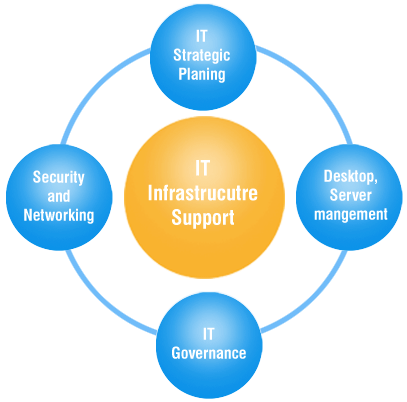
In today’s fast-paced digital world, businesses heavily depend on the efficient functioning of their IT infrastructure to remain competitive and meet customer demands. With the rapid advancements in technology, organizations must adopt proactive measures to manage their IT infrastructure effectively. This article explores the critical aspects of IT infrastructure management and the strategies required to ensure smooth operations.
The Importance of IT Infrastructure Management
IT infrastructure refers to the combined hardware, software, network, and services required to operate an organization’s IT environment. It serves as the backbone of any business, enabling the smooth flow of information, processes, and operations.
Efficient infrastructure management is essential due to the following reasons:
Improved Business Continuity: Unplanned system downtime can result in significant financial losses. IT infrastructure management ensures continuity by minimizing disruptions and quickly resolving any issues that may arise.
Enhanced Performance: Well-maintained infrastructure supports optimal performance, efficient resource allocation, and scalability, allowing businesses to meet evolving demands seamlessly.
Increased Security: A robust IT infrastructure management approach includes strong security measures to protect critical data, networks, and systems from cyber threats.
Cost Optimization: Effective infrastructure management helps identify and eliminate redundant or outdated components, reducing maintenance and operational costs.
Key Pillars of IT Infrastructure Management
A comprehensive infrastructure management strategy encompasses several key pillars:
1. Network Management
Network management involves monitoring, configuring, and optimizing an organization’s network infrastructure. This includes ensuring network performance, identifying and resolving connectivity issues, and maintaining network security.
2. Server Management
Server management focuses on maintaining the servers that host an organization’s applications, websites, and databases. It involves monitoring server health, managing software updates, and optimizing resource allocation to ensure optimal performance.
3. Data Storage and Backup
Efficient data storage involves managing both physical and virtual storage resources. Regular backups should be performed to ensure data integrity and protection against data loss due to hardware failures, human errors, or cyber threats.
4. Security Management
Security management aims to protect an organization’s IT infrastructure and data from unauthorized access, malicious attacks, and data breaches. It involves implementing firewalls, intrusion detection systems, encryption, and regular security audits.
5. Cloud Management
As organizations increasingly adopt cloud technologies, cloud management plays a crucial role in overseeing the cloud infrastructure. It involves monitoring and optimizing cloud resources, managing subscriptions, and ensuring compliance with security and privacy requirements.
Best Practices for Effective IT Infrastructure Management
Implementing these best practices can greatly enhance the effectiveness of IT infrastructure management:
1. Robust Monitoring and Alerting Systems
Deploying advanced monitoring and alerting systems allows organizations to proactively identify and address potential issues before they result in downtime or disruptions.
2. Regular Audits and Assessments
Conducting regular infrastructure audits helps identify areas for improvement, optimize resource allocation, and ensure compliance with industry standards and regulations.
3. Documentation and Change Management
Maintaining thorough documentation of the IT infrastructure and rigorous change management processes helps minimize errors, accelerate troubleshooting, and ensure consistency across the infrastructure.
4. Disaster Recovery and Business Continuity Planning
Establishing robust disaster recovery plans and backup procedures ensures prompt recovery and minimal downtime in the event of system failures, natural disasters, or cyber-attacks.
5. Continuous Staff Training
Investing in ongoing training and development programs for IT staff helps them stay updated with the latest technologies, best practices, and emerging trends, enabling them to effectively manage and secure the infrastructure.
The Role of IT Infrastructure Management in Future Success
In a rapidly evolving technology landscape, the role of IT infrastructure management has become even more critical for organizations. To remain competitive and meet customer expectations, businesses must stay ahead of emerging technologies, ensure security and reliability, and optimize their infrastructure for scalability and flexibility.
By implementing effective IT infrastructure management practices, organizations can unlock immense benefits, including increased efficiency, improved business continuity, stronger security, and reduced costs. An investment in robust IT infrastructure management paves the way for sustained growth and success in the digital era.
In conclusion, IT infrastructure management is the foundation upon which businesses build their technological capabilities. By prioritizing network management, server management, data storage, security, and cloud management, organizations can ensure smooth operations, minimize disruptions, and meet customer demands in today’s digital landscape.